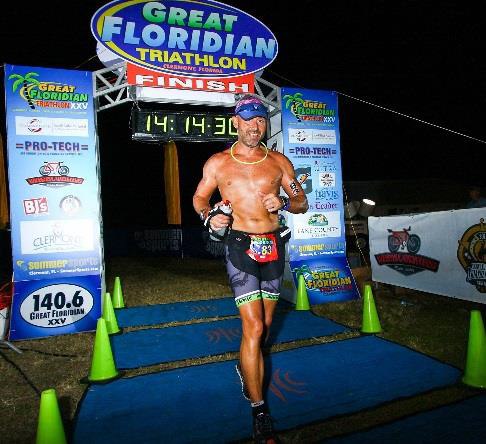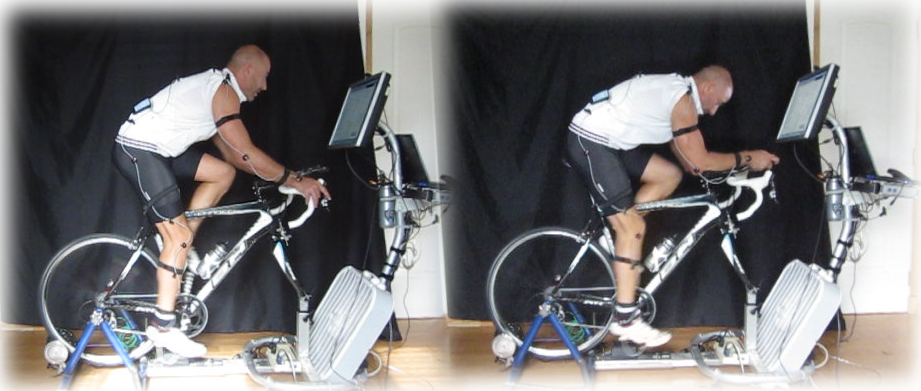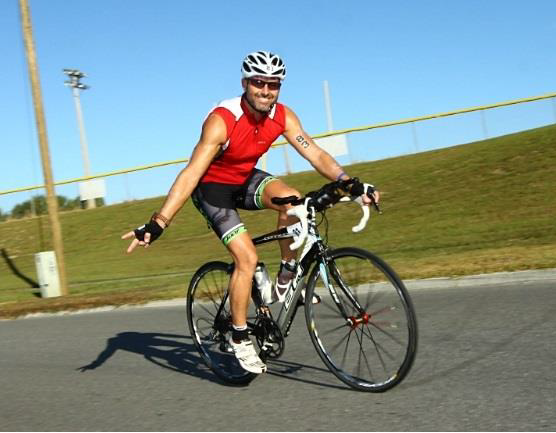|
Know anyone who can
benefit from this? Share! |
|
|
 |
 |
 |
|

Ironman:
How to succeed as a first timer.
The Great Floridian Triathlon
XXV with Mark Campbell
|
Are you tough enough?
That's the catchy tag line of the
Ironman distance triathlon. And indeed, it's a good
reminder that this type of ultra-endurance events are
not for the faint at heart.
Yet, the popularity of triathlons
is at an all-time high. More and more individuals delve
themselves into the obscurity of this question and go on
a soul-searching performance adventure that takes them
to the limits of their fitness and will power.
In this article, we take a
departure from our typical approach and introduce a very
well-written short story from one of our customers who
answered the call of the Ironman for the first time.
Mark Campbell is no ordinary man.
He lives for swimming, running and cycling. He loves the
self-reflecting quality of endurance, yet he had never
gone the full distance.
In this brief article, he recounts
the realities of what it takes to prepare emotionally,
physically and equipment-wise in a very concise and easy
to read way.
We helped him prepare. Not unlike
many of our customers, he is no Pro. He holds a real
job. He has a life outside training. And he has to
balance the demands of his life with those of the sports
he loves. |

Crossing the finish line below average time. A great
achievement for a 1st time Ironman! |

A good, efficient road bike position and a pure aero tri
position can be achieved with a few tricks and great
bike fitting technology like RetŁl 3D motion capture. |
A few months before this event, Mark
approached us for his bike fit. He uses a standard road bike for
all his activities. He wanted to know what we could do to
optimize his bike fitting so he could make the best of using
this bike versus a Tri-Specific model. To add to the challenges,
we learned that the course he chose for his Ironman debut was to
be very, very hilly.
Unusual for Florida, the amount of
elevation gain (some 6,500 ft!) would be challenge
enough. But it came in short, punchy climbs, punctuated
by equally fast and occasionally windy flats.
This is the holy grail of Tri bike
fitting: achieve both maximum aero and best climbing
performance.
Anyone who has ridden a Triathlon
knows the two don't quite seem to go well together.
Generally, you achieve one at the expenses of the other. |
|
We were able to turn what normally
would be a disadvantage -using a road bike instead of an
aero bike- into an asset. We
leveraged the road bike geometry and sized the stem
length so that Mark could be optimized using a standard
bull-horn handlebar and climb with his hands comfortably
in the hoods of his SRAM shifters/brakes.
Then we moved on to optimize the
aero bars as this were a true Tri bike, so we could
encourage a fully aerodynamic and powerful
position.
The result was that Mark found his
best performance on the bike no matter what position he
was in. We gave him the best of both worlds.
We diligently worked on our
process of running muscle de-activation, so we can save
muscle groups for the run .
Although it appears that the
intense heat, the amount of climbing and the enthusiasm
of the best bike-leg-of-his-life put Mark on the
collision course with cramping, he was able to work
through it and finish in better than average time, in an
Ironman event with more than 30% DNF rate. |

Doesn't he look like he feels a little too good after
100+ miles? |
We chose to tell his story because it's
representative of what most Ironman distance riders experience,
not only the first time. We chose to tell it because Mark
represents your average Joe triathlete - and we can all
relate to that. We chose to publish it because it's
representative of what bike fitting can do for an every-day,
normal cyclist when the spirit drives him/her to great
challenges.
So, without further ado, here is the
first-hand account from the man himself, Mark Campbell. It's good reading.
Enjoy.
MARK'S ACCOUNT:
The Great Floridian Triathlon XXV by Race
Finisher #83, Mark Campbell
Welcome to The Great Floridian Triathlon (GFT), the second
oldest ironman distance triathlon in the continental U.S. and
one of the few remaining independent ultras in the country. The
day-long journey consists of a 2.4 mile swim, 112 mile bike
ride, and a full marathon (26.2 miles). Over the years, I have
raced in a handful of triathlons of varying distances, but this
was my first ultra. On October 24 th
2015, I took on the
challenge of my first "iron-distance" triathlon, the 25th
anniversary of the
Great Floridian Triathlon. The slogan "Are you tough
enough?" has been attached to this race for decades, but
I didnít really have a reference point to fully comprehend what
this meant. Interestingly, statistics illustrate how this
relatively small race compares with the Ironman-branded events
held around the world, and why the slogan still fits,
particularly as a result of the changes made to this yearís bike
course.
Some statistics that are used to measure how difficult
a race is include the average finish time, and the Do Not Finish
(DNF) rate. The DNF rate is the percentage of competitors who
start a race but for whatever reason abandon the race or are
unable to finish within the 17 hour cut-off time. According to
www.runtri.com, which has
done extensive statistical analyses on triathlons, a handful of
the hardest-ranked Ironman races in the world (Texas, Wisconsin,
Kentucky, Malaysia and China) average approximately 13:20 hours
to complete, with DNF rates ranging between 8 and 12%. In
2012, the now-discontinued Ironman St. George in Utah had an
average finish time of 13:42 hours with a DNF rate of 14%,
including a difficult cumulative bike-segment elevation gain of
7,000 feet. Conversely, Ironman Florida is a flat and fast
course with an average 12:38 finish time and a low 4% DNF rate.
According to Sommer Sports Race Director Fred Sommer, only
about 60% of participants finish the Clermont GFT race
(Sun-Sentinel October 22, 2015), though the basis for this
statistic is unclear. Actual GFT race results over the last
three years (average finish time in hours and DNF rates) are as
follows: 14:28 / 20% in 2013; 14:16 / 20% in 2014; and 14:34 /
32% in this yearís 25 th
anniversary GFT
race. Thatís right, a whopping 32% DNF rate in
2015 with the slowest finish times in years! This yearís GFT
averaged about an hour slower and more than 2x the DNF rate than
the worldís statistically hardest Ironman race. This may have
largely been due to the most challenging bike course
in years that sent participants climbing over 6,500
feet total. The 3-lap bike course required competitors
to repeatedly climb Floridaís largest and steepest hills,
including Pitt St, The Wall, Buckhill Rd, and Sugarloaf Mountain
Rd.
Oftentimes, statistics are subject to misinterpretation due
to the many environmental variables at different race locations
on race day. We were fortunate to have racing with us John
Wragg aka "The Man with 200 Races", who at 65 years old
is the current world record holder for completing almost 200
ironman-distance races. As we discussed how difficult this
yearís GFT race was, he entertained us with stories of the
hardest races he has competed in and said that this yearís
GFT race was about the 5 th
hardest ironman he has ever completed. When we asked how
many different races John has competed in, he replied, "Iíve
done every different ironman in the world". I sheepishly said
with a grin, "This was my first ironman!" He peered down like a
big old cowboy and responded, "You picked a good one, Son" and
smiled.
As my first ultra-distance triathlon, I donít have much to
compare it to other than the handful of half-iron distances Iíve
completed over the years. I was pacing myself for a long day and
enjoyed the relatively wave or chop-free swim without the
excessive number of swimmers you typically find at the larger
Ironman-brand races. However, the lake water was very dark and
murky so you could not see your fingertips or the swimmers in
front of you. You just have to follow the bubbles! As I neared
the swim finish, I swam past the last large triangular buoy when
all of a sudden, "Whammo"! I plowed face first into some guy
holding onto the buoy.
Three months prior to the race, I was privileged to obtain a
professional bike fitting with Steffi Bici at A Perfect
Bike Fit Pro Studio (aperfectbikefit.com),
located in Hollywood, Florida. This was my first advanced bike
fitting using a highly sophisticated set up with computerized 3D
motion capture and power analysis from a RetŁl Certified Fitting
Center. The challenge, in my case, was to optimize both power
and position on a standard road bike with aero-bars. For years I
have cycled long-distance endurance rides in addition to the
short and fast group rides on my road bike. With all the
climbing, the road bike was the clear choice. But I felt I also
needed an optimized aerodynamic position for the long, flat and
windy stretches of road in this Ironman race. Steffi was very
methodical and leveraged her experienced to optimize my set up
for climbing while in the hoods of my drop bars and maximized my aerodynamics in
the aero bars for the fast sections. She went over all
components from cleats to aero-bars, even replacing the
seat-post for a more forward position. When the fitting was
complete, my power curves and leg rotation were perfectly
optimized. To my friendís dismay, there was a notable speed and
power improvement during my local group ride. As I took this new
bike setup into the hills of Clermont on training weekends, my
comfort and confidence grew with time. On race-day, it was
critical to know you have optimized your equipment to conserve
your limited supply of energy. This gave me the confidence and
calmness I needed as I exited the water and headed out on the
bike course.
Living three hours from Clermont, I had the luxury of
training on the bike course and all its hills many times
throughout the year. Training weekends with good friends made
the journey that much sweeter. We had so much fun spending the
days cycling in the hills and the afternoons lounging in the
pool or refueling at the local Tiki bar. On Race Day, I
traversed the hills and climbs with aplomb. It was a special day
to see my fellow competitors out there and I would constantly
wave at them and provide encouragement, ringing my little bike
bell as I passed. Yes, I purchased a cute little bike bell the
day before and rang it as I crested every climb with a smile!
You can't take yourself too seriously and one must never forget
this is what we do to have fun!
Although I felt good running out of the transition area, a
few miles into the run portion my legs were out of gas and began
to cramp. Did I push too hard on the bike leg? I felt so good,
could I have possibly forgotten to pace myself? The words of
Steffi's advice at the end of the bike fit echoed in my head:
"You'll feel good. You'll want to go faster. Don't go unto the
unknown. Pace at what you know brings you home." At this point,
my head was filled with questions. "How is my hydration?".
"Can I recover?". "What is the course of action here?".
I definitely had my doubts if my legs could survive another
24 miles. I persevered and continued to walk off the cramping. I walked through the drink stops every few miles,
took in electrolytes. The run course
was an "out and back" every few miles, passing the transition
area six times, offering plenty of opportunity to pass fellow
running friends and spectators. It was very encouraging to see
and cheer my local friends on the course, even stealing a few
hugs and smooches along the way. At some point I think my legs
just got tired of cramping since I would not listen to their
plea to hand-in my timing-chip and grab an early beer. After a
while, the sun began to set and the cooler air blew in. I
watched the mile markers climb from Mile 12 to 16, then 22, and
the realization finally set in that I was going to finish this
race no matter what.
At that point, the course almost felt downhill. My confidence
soared and I crossed the finish line with a time I felt I could
be proud of.
Most importantly, I learned the value of friendship,
preparation, and dedication. I enjoyed the swim and wanted to do
an additional lap thanks to Coach John Grzeszczak of Hammerhead
Aquatics (www.hammerheadaquatics.com)
in Wilton Manors. I donít think arriving poolside at 5:30 a.m.
ever gets easy. I felt confident and great on the bike in no
small part due to the professional bike fitting with Steffi Bici
at A Perfect Bike Fit Pro Studio. Finally, a big "thank you" to
my early morning running friends along Fort Lauderdale beach; a
beautiful way to start and honor each new day. I look forward to
continuing the training and nurturing the friendships Iíve made
along the way, because ultimately itís all about the journey.
The question is Ö Are YOU tough enough?
By Mark Campbell, First Time Ironman Finisher
OUR BELIEF:
"You don't have to be a Pro to get a bike fit. Everyone who
climbs into a bike deserves to have a great experience,
regardless of their fitness, expertise or equipment level."
A Perfect Bike Fit Pro Studio
Love your ride. Get a bike fit.
|
|
Visit Us. 
 Follow Us.
Like Us.
Follow Us.
Like Us.
|
|
|
Share Us. Don't keep it to yourself... |
|
© Copyright 2015 APerfectBikeFit.com. All rights reserved.
| For cyclists. By cyclists | Specialized in Bike Fitting, Sizing
and Performance | |
|
|
|